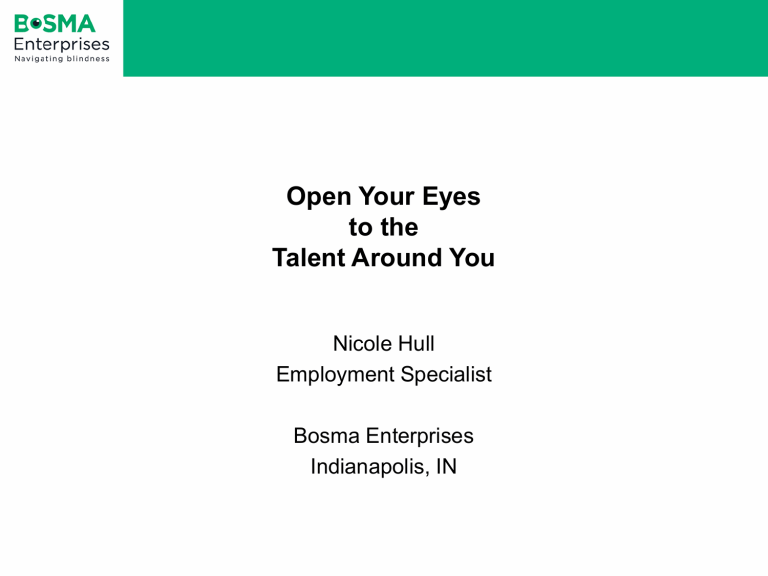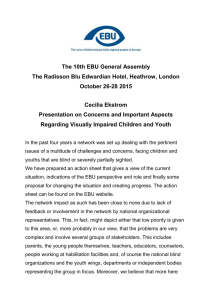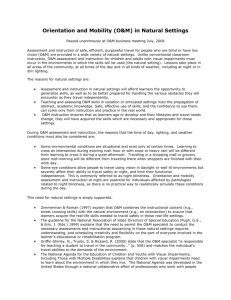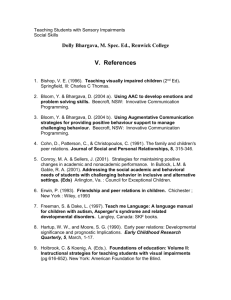Innovative-Practices..

Open Your Eyes to the
Talent Around You
Nicole Hull
Employment Specialist
Bosma Enterprises
Indianapolis, IN
Overview of Bosma Enterprises
• Not-for-profit organization located in Indianapolis
• Founded by the State of Indiana as the Board of
Industrial Aid for the Blind in 1915 and became an independent not-for-profit 501(c)(3) in 1988
• Provides training, vision rehabilitation, and employment services to individuals who are blind or visually impaired
• Bosma’s Mission is to create opportunities for individuals who are blind or visually impaired
• Bosma is putting people to work!
Objectives
• Understand the different types of visual impairments
• Expand the thoughts of employers and providers when working with someone who has a visual impairment
• Discuss the daily problem solving skills used by individuals who are blind or visually impaired
• Examine the fears managers have when hiring individuals who have a disability
• Explore reasonable accommodations in the workplace
Blindness as a Framework
What is Blindness?
• Visual Impairment – A person’s eyesight cannot be corrected to a “normal level”.
• Legally Blind – Visual acuity of 20/200 or worse with the best possible correction and a visual field of 20 degrees or less.
• Blindness – Visual acuity of 20/400 or worse with the best possible correction and a visual field of 10 degrees or less.
Types of Visual Impairments
• Diabetic Retinopathy - Diabetic retinopathy is a condition occurring in persons with diabetes, which causes progressive damage to the retina
• Symptoms include: Seeing spots or floaters in the field of vision, blurred vision, having a dark or empty spot in the center of the vision, difficulty seeing well at night
Types of Visual Impairments
• Glaucoma - a group of eye disorders leading to progressive damage to the optic nerve, and is characterized by loss of nerve tissue resulting in loss of vision. Majority caused by increased pressure in the eye
• Symptoms include: Sometimes a person will slowly begin to lose their peripheral vision, tunnel vision, and could eventually lose all vision
Types of Visual Impairments
• Macular Degeneration - 2 types (wet, dry)
• Dry: tissue of the macula gradually becomes thin and stops functioning properly. There is no cure, and any loss in central vision cannot be
• Wet: when fluids leak from newly formed blood vessels under the macula and blur central vision.
Vision loss can be rapid and severe
• Symptoms include: a gradual loss of ability to see objects clearly, distorted vision, a gradual loss of color vision, and a dark or empty area appearing in the center of vision.
Types of Visual Impairments
• Retinitis Pigmentosa - a group of inherited diseases that damage the light-sensitive rods and cones located in the retina, the back part of our eyes. Rods, which provide side
(peripheral) and night vision are affected more than the cones that provide color and clear central vision.
• Fortunately, most cases of retinitis pigmentosa take a long time to develop and vision loss is gradual. It may take many years for loss of vision to be severe.
Diversity Requires Broad Thinking
• Use “People First” language
• Address them by name (guess who?)
• Identify or Introduce Others
• Speak directly to the Person
• Use natural conversational tone and speed
• Be Specific and Descriptive
• Give Verbal cues
• Don’t be afraid to start a conversation with
“Did you see …”
Diversity Requires Broad Thinking
• Identify yourself when you walk into the room
• Make sure you also tell them when you leave
• Ask them what they see
• Ask if they want a sighted guide
• Do not grab or pull on the person
• Be as descriptive as possible
• When in doubt … ask!
Types of Accommodations?
• Computer accommodations – JAWS,
Zoom Test, Braille Display
• Magnifiers – CCTV (large or handheld)
• Scanner/Reader
• Orientation & Mobility
• Working with an employment specialist or job coach can make the process smooth
Did You Know?
• 90% of people who are legally blind have some usable vision and most can read print or magnified print?
• 88% of accommodations for B/VI cost less than $1000, 50% cost less than $500, and
15% cost nothing?
• Actual studies show that people with visual impairments do not have a higher risk for accidents than the general population of sighted workers? In fact, insurance statistics show they have a better safety record.
Did You Know?
• Consumers intentionally support businesses that employ people who are blind or otherwise disabled?
• 54% of households are more responsive to businesses that feature people with disabilities in their advertising?
• 1.5million Americans with vision loss use computers?
• People with visual impairments are the second largest group of people with disabilities in the United States?
Working in a Warehouse Setting
• Job Requirement: take a printout, pick orders from the racks, bring to shipping area, pack the boxes and ship
– Is it reasonable for a company of 3 employees to split the work of picking and packing orders?
– What about the same job in a company with
30 employees? 300 employees?
– Magnifiers, Orientation & Mobility
Working in Manufacturing
• Work environment: the assembly line is designed at a height to benefit standing workers
– Is it practical to lower the height of the line for a person in a wheelchair?
– What about installing a platform the wheelchair worker could use to raise them to required height?
– Accommodations needed for assembly work?
Office Based Service Role
• The company does work that relies heavily on telephones and computers
– Can a person who is blind or visually impaired do this job if they can’t see the screen?
– Would larger screens, magnifiers, or screen reading software packages be considered reasonable accommodations?
Sleeping on the Job
• Company is open 12-hours per day and employees work 8-hour overlapping shifts
• An individual has a medical condition requiring them to take extended breaks or naps during the day
– Could a split shift accommodate their needs?
– Might this also serve your company?
Transportation Woes
• Workers shift typically starts at 8:00 AM
• The worker relies on public transportation to get to and from work
• The bus arrives at 7:15 AM and 8:15 AM
– Is it reasonable to modify the workers schedule to start at 8:30 AM?
– What if they are the only worker who can do the job and the business needs to open to the public at 8:00 AM?
Conclusion
• Help is available from employment specialists and job coaches when you need it
• Employers who are open to accommodating the needs of their workers often have very happy, loyal, and productive employees
• Happy, loyal, and productive employees create delighted customers
• Delighted customers are repeat customers!
Fun Tools
• Goggles
• Dark-lined paper
• 20/20 Pen
• Identify large print preference
• Labeling items
– cans of soup
– Bleach/Tide
– Jelly vs. Pickles
My Information
Nicole Hull
Employment Specialist
Bosma Enterprises
Indianapolis, IN nicoleh@bosma.org
(317) 704-8185







